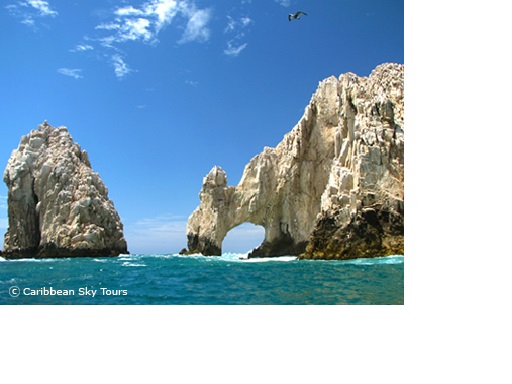 Sparkling blue waters, warm sunshine, fascinating ancient ruins, west coast whale watching, and first class resorts – Mexico and the Caribbean offer it all! And there’s no more beautiful way to see these spectacular countries than from the windows of your own private aircraft.
Sparkling blue waters, warm sunshine, fascinating ancient ruins, west coast whale watching, and first class resorts – Mexico and the Caribbean offer it all! And there’s no more beautiful way to see these spectacular countries than from the windows of your own private aircraft.
Getting there does take some preparation, as does flying within each of the countries, but with your homework done, you’ll find the trip was work the effort.
AOPA recently held a webinar on flying to Mexico, the Bahamas, and the Caribbean. If you missed it, you can listen to the recording at this link: https://goto.webcasts.com/starthere.jsp?ei=1027589. Woody Cahall, Vice President, AOPA Pilot Information Center and Rick Gardner, Director of Caribbean Sky Tours hosted the webinar, which was highly rated by the more than 700 attendees.
Procedures for flying south of the border vary depending on your destination country. Every country is different; each has its own set of rules and procedures. The easiest, least complicated destination to reach by private aircraft is The Bahamas. The most complicated is Mexico. Other Caribbean countries fall between these two in terms of complexity of procedures.
Here are the main pieces of information you need to know. Much of this applies to all destinations south of the border. Procedures specific to Mexico are identified.
There are regulations for the aircraft, the pilot, and the passengers.
- The aircraft needs an airworthiness certificate, a registration (a temporary, pink-slip registration will not do), a weight and balance sheet, a radio station permit, and 12” N-numbers.
- In addition, you will need a Mode C (S) Transponder, a two-way radio, 406 MHz ELT, as well as destination and overflight insurance, a Customs and Border Protection decal, aircraft logbooks, a notarized Declaration of Private Operations. If you have ferry tanks, you will need Form 337 aboard.
- The pilot will need to file a U.S. eAPIS manifest to leave and to return to the United States. Destination countries also have their own passenger information systems. Mexico’s is APIS, and though it is a new Mexican law (effective Dec. 31, 2013) and its application to general aviation is being discussed at a high government level, as of the time of this publication, it needs to be complied with. Caribbean countries have their own CARICOM (Caribbean Community) eAPIS.
- The pilot and passengers need valid passports, visas as required, medical insurance, and required vaccinations.
- Absolutely, do not bring firearms, ammunition, or illegal drugs!
In terms of equipment, you will need:
- Current navigation charts. Although you may choose to fly with electronic charts, bring paper charts, as well, as they may be requested by customs personnel in Mexico.
- FAA WAC charts and Mexico (NEGI) VFR WAC charts
- DOD IFR enroute charts
- Life jackets and/or life raft
Entering the country
You must enter and depart a foreign country from an Airport of Entry (AOE). Be sure to check the days and hours of operation. Check whether you need to call in advance for immigration or customs. Also, verify fuel availability and the method of payment. You’ll also want to be aware of fees – what they will likely be and method of payment. Many countries have requirements to obtain a Prior Permission Permit to over-fly, land, or fly within the country. The requirements and methods for obtaining the permit vary, so find out and be prepared ahead of time.
When you contact ATC, use the full tail number. Expect non-radar report. ATC will speak English, but it will likely be heavily accented. When VFR, advise U.S. FSS once contact is made with foreign ATC.
Entry to (Inward) and exits from (Outward) a country are done with a General Declaration form that documents where you came from. Each country has its own limits for how long an aircraft can remain in the country.
Flying in the Country
All flight between sunset and sunrise is to be flown IFR. Many foreign countries use the metric system, so be prepared! FAA Waivers, such as a single pilot waivers, are not always recognized by the country. International airspace is controlled by countries or agencies and are called “Flight Information Regions” or FIR. Almost all countries charge for the use of their airspace. There is a formula for calculating the fees, which are paid via wire transfer. Aircraft can be blocked from airspace or detained on the ground if fees are not paid.
Specific to Mexico
FAR 91.707 requires you to file a flight plan to Mexico. Where you enter and how you enter will determine the type of flight plan you file. Mexico requires advance notification, so put ADCUS. When you cross the Mexican border, if you are planning to overfly a border airport or continue into Mexican airspace you should report to the appropriate ATC facility.
Do not make any unauthorized stops prior to an Airport of Entry. If VFR from Florida, do not cross the Cuban inner ADIZ or come within 12 NM of the Cuban coast unless you are in contact with Cuban ATC and have received clearance to do so. When you arrive on the ramp in Mexico, you will likely be greeted by a soldier, often armed.
On arrival, you will need to obtain an entry permit: you can choose either a single-entry or a multiple-entry permit. Aircraft can remain in Mexico for a maximum of 180 days at a time. Usually, Mexican Immigration, Customs, and Civil Aviation (DGAC) will stamp your Arrival Report Form upon entering Mexico. We recommend you keep a copy. You will need to produce a letter of proof of insurance to the authorities – it’s a good idea to have the letter in Spanish, as well as in English.
In country, after you file your flight plan, remember to activate it! Then, fly the plan – do not deviate from it without ATC approval. For extra safety in Mexico, fly at higher altitudes – much of the country is mountainous. Fly early in the day – the warm temperatures increase density altitude and the performance of your aircraft. Always plan an alternate. When over the water, take positions of ships – there are many cruise ships in the Caribbean Sea and if you have to ditch, doing so within rescue distance of one of those ships isn’t a bad idea. Good emergency preparation would include oil and spare parts, a satellite phone, a flight tracking device, prop and throttle locks, a 406 MhZ PLB, a GPS with moving map, a machete (yes, you can bring a machete, but not a firearm!), and water.
When it’s time to come home to the United States, get a FSS briefing and check notams and TFRs. Make sure the Vice President isn’t playing golf near your U.S. airport of entry, which would be under a TFR. Here’s a handy homebound checklist:
- Plan your route
- Select foreign and U.S. AOEs
- Determine route, ETA, FIR boundary and ADIZ times
- File eAPIS
- Call IFSS in the U.S.
- Get flight briefing and provide flight plan Information
- Call CBP to notify of intended arrival (get a name and badge number)
- At the international AOE
- File ICAO flight plan
- Present Outward General Declaration
- Surrender aircraft permit documents
- Surrender immigration cards
- Pay applicable departure, airport and NAV fees
- Enroute
- Contact FSS prior to outer ADIZ if VFR
- Obtain a discrete transponder code
- Update ETA for CBP via FSS
- Arrival at U.S. CBP
- Have your paperwork in order
Registration
Pilot’s license
Medical certification
Passports - Taxi to CBP and wait. Neither the pilot nor any passengers are to leave the aircraft unless instructed to do so by CBP officers.
- Have your paperwork in order
Escorted Trips
If this sounds like too much work, don’t be discouraged. There are aviation tour companies that are expert at making these arrangements and offer escorted group trips to Bahamas, Mexico, and other Caribbean destinations throughout the year. Check out the scheduled trips and available resources at Caribbean Sky Tours, Caribbean Flying Adventures, Baja Bush Pilots, Air Journey, Pilot Getaways, and Bahamas Aviatorhttp://www.bahamasaviator.com/.
Questions? Give us a call in AOPA’s Pilot Information Center, Monday through Friday, 8:30 a.m. to 8:00 p.m. We will be glad to talk with you about your international travel plans.



